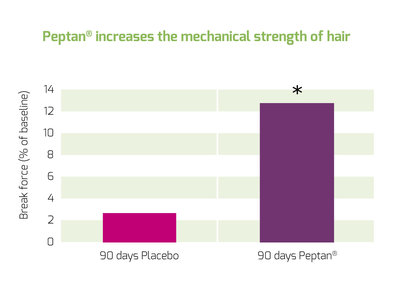Promoting smooth-looking skin with collagen peptides
The randomized, double-blind, placebo-controlled clinical research was conducted with 60 healthy Brazilian women, aged 45 to 60 years. During a set period of 90 days, a group of 30 participants received a 5g daily dose of Peptan collagen peptides from bovine origin (Peptan B) while the remaining subjects consumed a placebo control. Parameters of skin characteristics in the region of the cheeks, around the nose, eyes, mouth, as well as hair strength, were evaluated at baseline prior to supplementation and again 45 and 90 days after supplementation with high-end, state-of-the-art techniques.
Results showed significant improvements in the overall appearance of the skin, characterized by a decrease in periorbital wrinkles by 13% and nasolabial wrinkles by 10% of the Peptan-supplemented participants. At the basis of those observations was a clear increase of the density of the dermis, which contains the strength-providing collagen layer of the skin, following Peptan supplementation.
Bringing new scientific evidence for hair strength
While collagen is known for promoting stronger and healthier hair, there has been no scientific assessment of these beauty benefits until now. This new study evaluated the characteristics of hair using a texturometer before and after Peptan supplementation clearly demonstrating an increase of the mechanical strength of the hair by 13% in the Peptan group compared to the placebo group. Mechanical strength is linked to improved properties of the hair cortex, which can be especially beneficial for aging hair.
Broadening Peptan’s Scientific Portfolio for Skin Beauty
Previous clinical reports have demonstrated that oral collagen peptide supplements can reduce the signs of skin aging by improving skin hydration2,3,4,5, elasticity3,4,5 and dermal collagen density2. The new scientific evidence using Peptan broadens the understanding of benefits delivered by Peptan collagen peptide supplementation for beauty in several ways. It provides further evidence on the efficacy of Peptan collagen peptides from bovine origin, at a lower dose. Conducted in a Brazilian population of mixed skin and hair types, this also brings additional proof that Peptan is efficacious across populations of different ethnical backgrounds, adding to the previous evidence obtained from trials in Caucasian and Asian populations2.
Peptan’s range of collagen peptides are safe, bioactive and developed through an optimized hydrolyzation process, which makes collagen peptides highly bioavailable, and provide targeted benefits in the key connective tissues of the human body. A leading global brand of choice, Peptan collagen peptides are widely used in nutricosmetic applications and continue to grow in popularity among manufacturers looking to differentiate their products, thanks to the wealth of vital information supplied by Rousselot’s extensive scientific research.
To find out more about the latest science on Peptan collagen peptides, download Peptan’s white paper ‘Collagen peptides for promoting skin beauty and hair health’: https://www.peptan.com/about-peptan/downloads/collagen-peptides-for-skin-beauty-and-hair-health
References
[1] Rousselot unpublished study
[2] Asserin, J et al. The effect or oral collagen peptide supplementation on skin moisture and the dermal collagen network: evidence from an ex vivo model and randomized, placebo-controlled clinical trials. J of Cosmetic Dermatol 2015; 0 – 1-11
[3] Matsumoto H et al Clinical effects of fish type I collagen hydrolysate on skin properties. ITE Letters on Batteries, New Technologies and Medicine 2006; 7 (4): 386-390
[4] Ohara H et al Improvement in the moisture content of the stratum corneum following 4 weeks of collagen hydrolysate ingestion. Food Science and Technology Research 2009; 56 (3): 137-145
[5] Inoue N et al Ingestion of bioactive collagen hydrolysates enhance facial skin moisture and elasticity and reduce facial ageing signs in a randomized, double-blind, placebo-controlled clinical study. J Sci Food Agric 2016; 96(12):4077-81



